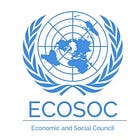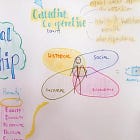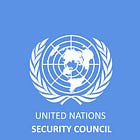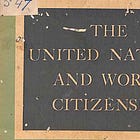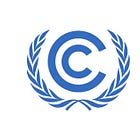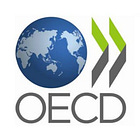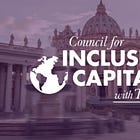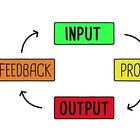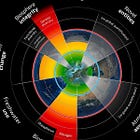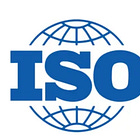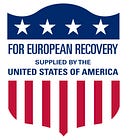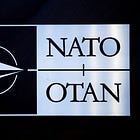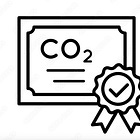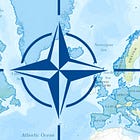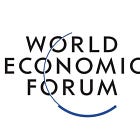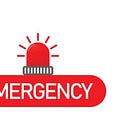Conditional Sovereignty - Part 1
How Planetary Stewardship Quietly Subordinated the Sovereign State
Sovereignty is no longer an absolute shield. It has become conditional on responsibilities, performance metrics, and algorithmic thresholds. What emerges is planetary stewardship as the organising principle, quietly subordinating the old notion of unfettered sovereign authority.
This is how eligibility — encoded in standards, dashboards, and thresholds — now governs what sovereigns can actually do.
The moral compass that migrated into economics.
What began as an argument about ends (‘what’s the good we’re aiming at?’) was wired into means (‘route money and production toward those ends’). Credit, budgeting, and oversight were recast as moral instruments for social purpose. At the same time, global diplomacy stopped being purely episodic. Permanent technical bodies — health, labor, standards, communications — kept governing between treaties, so authority started flowing to function-specific international organisations that run continuously.
The clearinghouse ‘expert panel’ logic in finance scaled from the city of London to the planet: multilateral payments, shared rules, lender-of-last-resort culture — all ultimately conditional upon clearance from above, with the Bank of England residing at the apex. Post-war designers coupled that monetary spine to a standing committee system — a Security Council executive trigger for crises and a technical global modelling agency for everything else, coordinated through ECOSOC. Inside governments and lenders, the discipline shifted from edict to evidence: plan → measure → pay. Program budgeting, logframes, evaluations — soon results became the common language, with surveillance data used for control.
Then the scope went planetary. Environmental governance made the Earth legible — satellites, monitoring networks, verification protocols, and carbon ledgers turned atmosphere and ecosystems into measurable things. Health did the same for biology: one set of vocabularies and databases spanning people, animals, and environments. The recipe was simple and powerful: legibility → comparability → eligibility. Once signals look the same everywhere it allows for thresholds to become trade rules, loan covenants, procurement clauses, and supply-chain requirements.
Sovereignty was reframed as responsibility1; failure to meet baseline duties became grounds for outside action, with the Security Council holding the right to call for force projection2. Courts and charters through ‘EcoCide’34 currently work to elevate the ‘right to a healthy environment’5 ‘regardless of direct impacts on people‘6, letting ecosystem thresholds themselves act as triggers for executive action — potentially even military.
Platforms embedded these conditions through identity wallets, product passports, open-contracting formats, e-procurement, and standards thus became conditions and the enforcement of these conditions was progressively automated. When you understand that conditional finance is the first gate with pre-authored emergency thresholds, you get the current condition: conditional finance → conditional governance → conditional sovereignty, all pointed — by design and feedback — at Planetary Stewardship, where a sovereign failure to abide the Earth Charter’s planetary ethic with time could well become a crime of ‘EcoCide’.
Seen end-to-end, these six rails collapse into one track. Moral purpose was fused into economics (money routed to declared goods); economics was generalised into systems (feedback, budgeting-by-metrics); systems became the baseline for permanent international institutions (clearinghouses, councils, standards bodies) that governs continuously; that machinery was legalised (responsibility doctrines, ecocentric rights, due-diligence duties) turning thresholds into law; this law was encoded in platforms (identity, passports, procurement, MRV) so standards became conditional gates, closing when thresholds are crossed; and the gates take input indicators that span environment, economy, and social ‘justice’ with an explicitly intergenerational horizon, meaning you could be judged for past crimes your grandparents were allegedly guilty of, per opaque ‘black box’ models you cannot realistically protest.
One logic, six faces — morality → economics → systems → institutions → law → indicators/thresholds — steering toward the same destination.
And this entire track is impeccably aligned with Alfred Zimmern’s 1926 call for international social justice, governed through economics.
This all now runs through routine pipes:
Socio-economic determinants tracked by national statistics and household surveys;
Public-health surveillance via lab-confirmed reporting and genomic sequencing;
Global biodiversity and land-use seen from satellites and sensor networks.
These streams are now normalised into SDG indicator suites and sector dashboards, then folded into MRV (monitoring, reporting and verification) regimes for emissions, deforestation, and financial transparency.
Once legible and comparable, they become conditional gates carried by concrete instruments: finance (IMF/WB prior actions, DLIs, climate funds), market access (EU product passports, deforestation due-diligence rules), procurement (OCDS/e-proc auto-validation that blocks non-compliant tenders), and recognition (FATF lists, accession chapter progress). In practice, the main throttle is money — but the same indicators now quietly decide who trades, who builds, and who gets a seat at the table, while manipulatively dressing this up in language of ethical imperative.
In a declared pandemic…
… they don’t just control access — they write the full script. A shared ethic (‘protect life’), routed through emergency finance and model-driven dashboards (case count of 80 per 100,000 means lockdowns without democratic deliberation), is instantiated by WHO’s IHR and domestic emergency powers so legal triggers bind institutional action to public health indicators (Rₜ, test positivity, ICU load, model projections) with accompanying thresholds not up for democratic debate.
The result during Covid was policy by threshold rather than parliamentary deliberation: tiered lockdowns, travel bans, school closures, masking rules, and even the timing of fiscal support when conditions were met — while the public was nudged along with promises of free donuts7, burgers8, scholarships9, and prize draws10 for accepting direction without challenge, thus likening you to a mouse in a Planetary Skinner box, being rewarded with ‘equity’ for compliance. Yet, once indicator thresholds steer money, markets, Skinner box ‘equity’, and emergency rules, sovereignty becomes performance theatre — conditional by design.
And all this was progressively developed across six tracks — morality → economics → systems → institutions → law → indicators/thresholds — ultimately realising Alfred Zimmern’s 1926 call for international social justice through economic governance.
Stated plainly
Think of a country’s sovereignty — its right to govern itself — not as an absolute right anymore, but like a driver’s license conditional upon behaviour on the road. Just as your license depends on you following traffic laws, a nation’s ‘license to operate’ now depends on it meeting obligations outlined through global performance metrics. These metrics — like carbon emission targets, economic transparency, or public health standards — are tracked by satellites and databases, and forward predicted by Digital Twins and other ‘black box’ global modelling tools. If a country fails the World Bank’s ‘governance indicator’11 tests — or a sovereign grant conditional upon SDG Indicator12 performance — it can automatically face real consequences, like losing access to compensation, trade sanctions, or even facing legal action tried at the ICC in Hague, all in the name of ‘planetary stewardship’1314.
This system works like a silent, automated scoreboard. During the COVID pandemic, we saw it in action: instead of parliaments debating, pre-set thresholds (like ICU capacity or infection rates) automatically triggered lockdowns and travel bans. This shows how global rules, embedded in financial systems and digital platforms, now quietly dictate what governments can and cannot do. Your nation is ultimately graded on its compliance, turning sovereign power into a conditional privilege managed by international institutions.
Sovereignty is no longer a right, but an ‘equitable’ reward for following the rules set by an increasingly automated global system.
And the Planetary Skinner box15 metaphor applies to the sovereign, enterprise and individual all alike. None shall fail to carry out their ‘black box’-mandated ‘ethical imperative’, lest they be considered immoral deviants, and have the full force of the future algorithmic authoritarianism thrown at them in retaliation.
The six tracks
Moral telos (the ‘why’)
1837–1841 — Moses Hess: Holy History of Mankind16 / European Triarchy17 → socialism framed as a moral project; economy as instrument of ethical regeneration.
1884 — Fabian Society: founded to pursue ‘the highest moral possibilities’ via gradual, expert-led reform.
1926 — Alfred Zimmern, The Third British Empire: international social justice named as telos, to be realised through economic coordination.
1945–1946 — UNESCO Constitution: education/culture cast as a global ethical mandate (‘since wars begin in the minds of men…’).
1948 — Universal Declaration of Human Rights: universal moral grammar for legitimacy and duty.
1949 — The United Nations and World Citizenship (UNESCO): teachers-as-multipliers strategy; ethics of world citizenship diffused through education.
1982 — World Charter for Nature: ecocentric ethic — protect nature for its own sake, not only for human use.
1992 — Rio Declaration on Environment & Development18: principles binding human development to planetary limits (precursor ethic for SD/precaution).
1993 — A Global Ethic19 (Parliament of the World’s Religions; Hans Küng): cross-tradition consensus on minimal shared moral commitments.
2000 — Earth Charter: integrated planetary ethic20 — respect for nature, human rights, economic justice, peace.
2015 — Sustainable Development Goals (SDGs): moral ends (environment, economy, social) codified as goals → targets → indicators (the ‘ethic’ is judged through measurable surveillance data).
Monetary/clearing (the control lever)
1770s–1844 — City clearing → central note power. London Bankers’ Clearing House standardises multilateral settlement; 1844 Bank Charter Act21 centralises note issuance under the Bank of England.
1892 — International gold clearing through receipts. Julius Wolf proposes a gold‐based international clearing mechanism which later is picked up by the BIS (multilateral netting beyond bilateral diplomacy).
1930 — BIS founded. The Bank for International Settlements becomes the central-bank ‘switchboard’ for liquidity coordination, standards, and quiet crisis management.
1944–46 — Bretton Woods rails. IMF (balance-of-payments finance) + IBRD/World Bank (reconstruction/development; Zimmern’s international social justice) install the monetary layer under a USD–gold anchor.
1950–58 — European Payments Union. Post-war Europe runs on a multilateral clearinghouse; convertibility restored in 1958—choice becomes clearance by design.
1969–73 — SDRs & the float. SDRs created as reserve asset; 1971–73 end of gold peg → generalised floating with IMF ‘stability’ intact.
1970–74 — Wiring + oversight. CHIPS (1970) and SWIFT (1973) standardise cross-border messaging/settlement; Basel Committee (1974) launches global bank-supervision coordination.
1988–2010s — Basel capital era. Basel I (1988) risk-weighted capital; 1996 market-risk add-on; Basel II (2004) internal models; Basel III (post-2008) liquidity/leverage—prudential standards become access gates.
1999–2002 — Euro & ECB. A continental unit of account and settlement function.
2008–09 — Fed swap lines + IMF programs demonstrate transnational lender-of-last-resort capacity as policy lever.
2015–2020s — ISO 20022 messaging migration, instant payment rails (SEPA Instant, FedNow), and CBDC pilots extend programmability and compliance hooks into the core payments stack.
Systems theory & Cybernetics (the ‘how’ of steering)
1940s — OR & feedback. Wartime operations research, radar control rooms, and anti-aircraft fire control normalise sense–predict–correct loops22.
1946–53 — Macy Conferences synthesise cross-disciplinary control23; Wiener (1948) on cybernetics24; Shannon (1948) information theory25; von Neumann–Morgenstern (1944) formalise strategic choice26.
1950s — Ashby (1956) ‘law of requisite variety’27 (control needs matching complexity); Simon (1957/1969) bounded rationality refines decision design28; Boulding (1956) adds hierarchy to Bertalanffy’s General Systems Theory29.
1958–61 — SAGE air-defense system pioneers continent-scale, real-time, screen-based command-and-control30 — a proto-dashboard.
1961–69 — Forrester (1961) system dynamics; USAID founded31 (1961); US DoD’s PPBS32 (1961) ties plans to measures and money before McNamara brings it to the World Bank33 (1968); USAID’s Logical Framework34 (1969) makes plan → measure → pay explicit.
1966 — Spaceship Earth: Boulding proposes viewing Planet Earth as a closed General Systems Theory model35, thus serving as a precursor to Pearce/Turner’s Circular Economy36 (1990).
1966–72 — Managing complexity. Stafford Beer (1966; VSM 1972) organises enterprises as control systems37; IIASA (1972) institutionalises global modeling; Limits to Growth38 (1972) popularises world models.
1968 — UNESCO Biosphere Conference. First major event to treat the entire planet as a full, encapsulated system.
1970s — Adaptive management & telemetry. Holling’s adaptive environmental assessment39 (mid-70s); SCADA40 and early GIS wire infrastructure and geography into monitoring-and-control41.
1987–96 — Management systems meet metrics. ISO 9001 (1987), Balanced Scorecard42 (1992), ISO 14001/EMAS43 (1996) fuse quality/enviro objectives with auditable indicators — KPIs as governance habit.
1990s — RBM formalised. OECD-DAC/UN44 codify Results-Based Management; evaluation units and scorecards standardise ‘outputs→outcomes→impacts’ chains.
2000–10s — Dashboards at scale. Data warehouses → executive dashboards; digital twin idea (2002) migrates from engineering to cities/sectors; Basel II internal models hard-wire model risk into supervision45; open data specs make spend machine-readable.
2020s — Automated thresholds. Nowcasting/AI forecasts, sector digital twins, and model governance/MLOps push Sense→Model→Decide→Act loops into finance, health, climate. Pre-authorised playbooks bind triggers (indicators) to actions (funds, restrictions, waivers).
Functional (the institutional form)
1865–1919 — Permanent technical unions. ITU46 (1865) and UPU47 (1874) make continuous, specialist rule-making normal; ILO48 (1919) pioneers tripartite standard-setting (states–employers–workers).
1919–1930 — League committees & monetary club. League of Nations’ health/labour/economic bodies govern between treaties; BIS (1930) gives central banks a standing coordination hub.
1944–1946 — Operating system installed. ICAO49 (Chicago 1944) standardises air; IMF/World Bank50 (1944) add monetary clearing & development finance.
1945 — UN Charter: UNSC as executive trigger, ECOSOC to orchestrate specialised agencies + Art. 71 NGO consultative status51; FAO/WHO/UNESCO launch.
1947–1961 — Metrics + peer review. ISO52 (1947) globalises standards; GATT53 (1947) embeds trade rules.
1948 — The Marshall Plan: OEEC (1948)→OECD (1961) with DAC peer reviews; Council of Europe (1949)/ECHR (1950) judicialises rights; NATO (1949) introduces STANAG interoperability
1956 — NATO’s Committee of Three for non-military cooperation.
1957–1992 — Regional functionalism. EEC/Euratom54 (1957) create acquis + comitology (standing committees); Maastricht55 (1992) upgrades to EU — continuous law-by-procedure.
1957–1989 — Safety & finance standard-setters. IAEA56 (1957), Codex Alimentarius57 (1963); Basel Committee58 (1974) and FATF59 (1989) spread mutual evaluations and ‘comply-or-be-priced-out’ supervision.
1972–1992 — Green secretariats. UNEP60 (1972); regime complexes with standing secretariats: CITES61 (1973), Montreal Protocol62 (1987), CLRTAP63 (1979); Rio (1992) births UNFCCC/CBD + Agenda 21 machinery.
1994–2005 — Globalisation of review. WTO64 (1995) with Trade Policy Review; IPCC65 (1988) institutionalises science-to-policy; GEF66 (1991) finances compliance; WHO IHR (2005) revision binds national core capacities & notification.
Late-1990s–2000s — Multi-stakeholder turn. ICANN67 (1998) for the DNS; Global Public Policy Networks68; UN Global Compact69 (2000); public-private standards become governance via supply chains.
2010s — Indicators as process. SDG VNRs70 (2016→) formalise national reporting; Paris Agreement transparency (2015) normalises MRV; Open Contracting Partnership/OCDS71 (2012/2014) make spend machine-readable.
2016–2020s — Resilience & platforms. NATO 7 Baseline Requirements72 (2016) extend ‘readiness by checklist’; eIDAS 2.073, Digital Product Passports74, and e-procurement/eForms/ESPD75 embed rules in platform workflows — turning standards into gates that run continuously.
Legal (the doctrine)
1948–1950 — Rights become justiciable. UDHR (1948) sets the moral ledger; ECHR (1950) + Strasbourg court make rights enforceable against states (access to court, proportionality, positive obligations).
1972 — Stockholm Declaration (1972) gives birth to the UN Environment Programme76 (UNEP).
1982 — World Charter for Nature77 (1982) ground stewardship; Rio (1992) Principles harden precaution (15), polluter-pays (16), prior EIA (17), and CBDR under UNFCCC/CBD—the legal grammar for acting on modeled risk.
1995–2000 — Trade & transparency hooks. WTO SPS/TBT make science-based, risk-based standards reviewable; Aarhus (1998) codifies access to environmental information, participation, and justice—fuel for dashboard contests.
1999–2005 — Sovereignty as responsibility. Kosovo (1999) crystallises legality/legitimacy split78; ICISS/R2P (2001) reframes sovereignty as a duty79; 2005 World Summit 138–139 enshrines that failure can shift authority outward80. In health, IHR (2005) binds core capacities81 + Annex 2 trigger logic for PHEICs82.
2000s–2010s — Due diligence & extraterritorial reach. Courts build positive obligations (life/health/environment); states adopt EIA/SEA83, non-regression, transboundary harm duties84. Corporate statutes arrive: France Duty of Vigilance85 (2017); Germany LkSG86; EU moves to value-chain sustainability due diligence87 — globalising enforceable care duties.
2014–2015 — Security expands, climate binds procedures. UNSC 217788 (Ebola) and 130889 (HIV/AIDS) treat health as peace & security; Paris Agreement90 (2015) normalizes MRV, transparency framework, and rolling NDC review—procedural law for permanent thresholds.
2017 — Ecocentric turn. AO-23/1791 recognises an autonomous right to a healthy environment, protecting ecosystems irrespective of human harm; courts extend remedies (e.g., rights-of-nature cases, intergenerational claims).
2021–2022 — Planetary rights & future persons. Our Common Agenda92 (2021) argues for protecting global commons; UNGA 76/30093 (2022) recognises the right to a clean, healthy, sustainable environment — a universal hook for conditioning state action. Constitutional courts (Urgenda 201994) tie climate ambition to rights and future generations.
2020s — Algorithmic & platform governance meet public law. GDPR (Art. 22), AI-risk regimes, EU Taxonomy/DNSH, CSRD bring ‘compliance by data’ and automated decision safeguards into hard law95; product passport / eID / e-procurement mandates make legal thresholds executable by platforms96.
2023+ — Emergency choreography. UN Emergency Platform policy framing proposes pre-authorised convening and cross-rail activation for “complex global shocks,” aligning doctrinal triggers (precaution, R2P, IHR) with real-time gating.
Indicators (the surveillance architecture)
1996–2016 — Indicators go global. IMF SDDS/e-GDDS and UN MDGs→SDGs install common scoreboards; IAEG-SDGs fixes the global indicator list; OECD/DAC peer reviews and ISO families give metrics a shared grammar. Net effect: data comparability becomes the precondition for eligibility.
2013–2019 — Procurement data becomes code. Open Contracting Data Standard (OCDS) (v1.0→) + EU ESPD (supplier self-declarations) + EU eForms (structured tender fields) turn tenders, awards, and supplier checks into machine-readable events. Net effect: compliance can be auto-validated at publish/award time.
2015–2022 — Transparency & risk rails. Beneficial-ownership registers, LEIs for entity IDs, TCFD climate risk disclosure, EU SFDR/Taxonomy/DNSH/CSRD shift ESG from brochureware to digitally tagged, auditable disclosure. Net effect: sustainability claims become data targets that can gate finance and listings.
2005–2024 — Health triggers by indicator. IHR (2005) Annex 2 embeds the yes/no algorithm for PHEIC notification; event-based surveillance + genomic reporting standardise alerts; EU Digital COVID Certificate demonstrates credential-gated mobility. Net effect: epidemiological thresholds can trigger binding measures across borders.
2014–2026 — Identity as access layer. eIDAS (2014) cross-border eID trust; eIDAS 2.0 / EUDI Wallet (2024) extends to high-assurance credentials (IDs, licenses, diplomas). KYC/AML harmonisation ties wallets to finance. Net effect: services, benefits, and transactions can be gated per-person, per-credential.
2023–2026 — Product traceability as market gate. ESPR Digital Product Passport (registry + delegated acts) and Batteries Regulation pilot the DPP—unique IDs + lifecycle data as a condition for sale. Net effect: supply chains become scan-to-comply; no passport, no market.
2016→ — Procurement-as-code platforms. ProZorro (UA), MTender (MD), GHANEPS (GH), PhilGEPS (PH) implement OCDS/eForms/ESPD + rule engines: mandatory fields, auto-exclusion, threshold checks. Integration with IFMIS (commitment control) links award → contract → payment. Net effect: a non-compliant tender can’t be published/awarded; a non-compliant invoice can’t be paid.
2018→ — Spend & milestone APIs. Platform fields bind milestones/targets to disbursements (PforR, DLIs); payment webhooks flip only when evidence objects (docs, IDs, geotags) validate. Net effect: tranche money moves on platform signals, not memos.
2020s — Digital twins & registries. Project registries (national DREAM-style systems), RDNA methods, BIM/geo fields, and satellite MRV wire assets and works into live ledgers. Net effect: physical progress and environmental performance become continuously observable.
In part two we investigate where this all leads.




